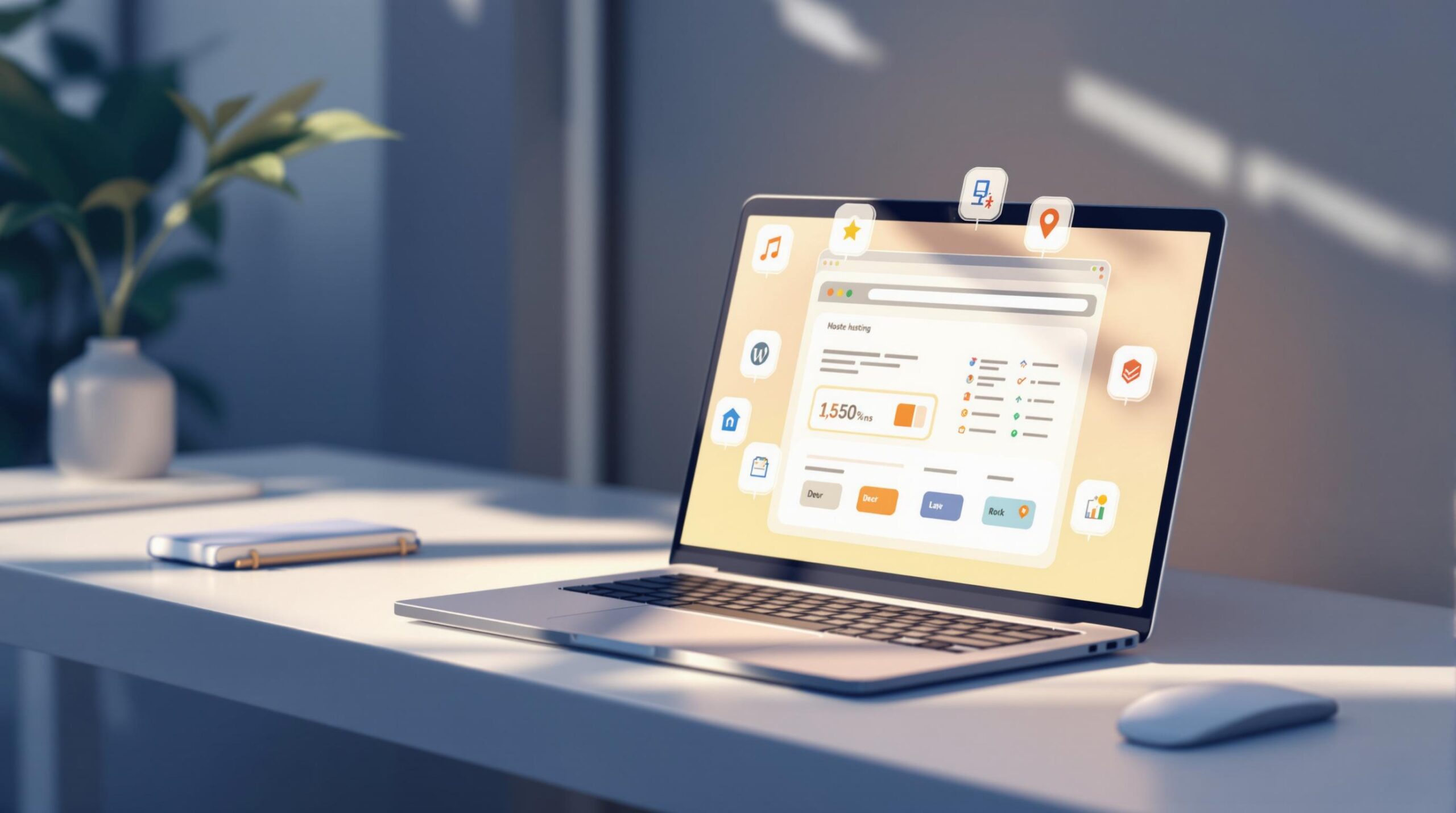Common WordPress Hosting Issues and Solutions

WordPress hosting problems can slow down your site, hurt security, and cause downtime. Here’s what you need to know to fix these issues:
- Slow Speeds: Caused by heavy themes, too many plugins, or uncompressed images. Solutions include caching, using a CDN, and optimizing server settings.
- Downtime: Often due to resource limits, hardware failures, or cyberattacks. Monitor uptime, back up your site, and balance traffic loads.
- Security Risks: Weak passwords, outdated plugins, and malware are common threats. Use SSL, two-factor authentication, and regular updates to protect your site.
- Growth Challenges: Shared hosting struggles with high traffic. Upgrade hosting, optimize databases, and use load balancing to scale.
- Software Conflicts: Plugin or theme issues can cause crashes. Test updates in a staging environment and troubleshoot conflicts one by one.
Quick Fixes:
- Enable caching and compression.
- Use strong passwords and two-factor authentication.
- Monitor uptime and server logs regularly.
- Back up your site daily.
These steps ensure your WordPress site stays fast, secure, and reliable.
Top 10 WordPress & Hosting Issues (& how to fix them!)
Fix Slow Website Loading Times
A slow website can hurt your WordPress site’s performance. Studies reveal that 40% of users will leave a site if it takes more than three seconds to load. Below are steps to address common speed issues.
Why WordPress Sites Run Slowly
Several factors contribute to slow WordPress sites. Heavy themes packed with unnecessary features can bloat your site, while too many plugins can overburden server resources. Large, uncompressed images are another frequent culprit behind sluggish performance.
How to Optimize Server Settings
Adjusting server settings can improve your site’s speed. Here are recommended PHP-FPM configurations based on traffic levels:
| Traffic Level | Max Children | Process Idle Timeout | Max Requests |
|---|---|---|---|
| Low/Medium | 4 | 60 seconds | 120 |
| Medium/High | 8 | 60 seconds | 120 |
| High | 16 | 90 seconds | 180 |
For better results, configure Opcache with the following settings:
- opcache.memory_consumption: 256MB
- opcache.max_accelerated_files: 32,767
- opcache.revalidate_freq: 90 seconds
Enable compression at the server level to reduce file sizes. Use mod_deflate for Apache or gzip for Nginx. Additionally, set HTTP Cache-Control and Expires headers to enable browser caching, allowing static resources to be stored locally on users’ devices.
Advanced caching can further enhance your site’s performance.
Speed Up Sites with Caching and CDNs
Caching is a powerful way to reduce server load and improve response times. Tools like Redis or Memcached can speed up database queries by storing frequently accessed data in memory.
For a global audience, a Content Delivery Network (CDN) can help. CDNs store your site’s static assets across multiple locations, ensuring users access content from the server closest to them.
Dynamic caching strategies can include:
- Page caching for static content
- Browser caching for images, CSS, and JavaScript
- Database query caching
- Object caching for repeated data requests
Prevent and Fix Website Downtime
Website downtime can severely impact your site’s performance and revenue. On average, websites face three hours of host downtime monthly and experience 760 outages annually. Tackling downtime is just as important as optimizing your site’s speed and security.
Common Causes of Downtime
There are several reasons your website might go offline:
- Resource Limits: If your site exceeds CPU, RAM, or bandwidth limits, your server might crash. Regularly check your resource usage to avoid this.
- Hardware Failures: Issues like server hardware malfunctions, power outages, or overheating can lead to downtime. While data centers often have backup systems, disk failures still pose a risk.
- Cyber Threats: With around 2,220 cyberattacks happening daily, malware and DDoS attacks are a real danger. Invest in strong security measures.
- Software Conflicts: Updates to WordPress core, plugins, or themes can sometimes cause compatibility problems. Schedule updates during low-traffic times to reduce disruptions.
Monitor Uptime and Back Up Your Website
Keeping your website online requires effective monitoring and a solid backup plan. Here’s how you can stay on top of things:
-
Uptime Monitoring: Use tools to check your site’s availability at set intervals. Set up alerts through different channels for quick responses:
Alert Type Response Time Best For Email 1–5 minutes Detailed reports SMS Immediate Critical issues Push Notifications Real-time Urgent responses - Review Server Logs: Regularly analyze logs to spot recurring errors or unusual activity.
- Backup Plan: Keep your backups up-to-date, store them in multiple locations, and test them periodically to ensure they work when needed.
Manage Traffic to Avoid Overloads
Even with proactive monitoring, traffic surges can overwhelm servers. Here’s how to handle it:
- Load Balancing: Spread incoming traffic across multiple servers to prevent any single one from being overwhelmed.
- Health Checks: Use automated systems to monitor server performance, check response times, and reroute traffic away from servers that aren’t working properly.
sbb-itb-d55364e
Strengthen WordPress Security
With WordPress being one of the most widely used platforms, it also becomes a prime target for cyberattacks. Cybercrime damages are expected to hit $10.5 trillion annually by 2025, and a concerning 35.3% of WordPress sites still operate on outdated software. Taking proper security measures is essential to protect your site.
Common WordPress Security Threats
WordPress’s popularity makes it a frequent target for attacks. For instance, SQL injection alone is responsible for over half of reported incidents. Other threats include brute force attacks, malware infections, and cross-site scripting, all of which can disrupt your site’s performance and compromise its data.
Basic Security Steps
- Update Management: Regularly update WordPress core, plugins, and themes. Use strong passwords that include symbols and numbers.
- Access Control: Set up two-factor authentication, limit login attempts, change the default database prefix, and disable PHP error reporting.
Extra Security Measures
Once you’ve covered the basics, you can enhance your site’s protection with more advanced strategies.
-
Server-Level Security:
- Install SSL certificates to secure data transmission.
- Use a web application firewall to block malicious traffic.
- Disable XML-RPC to reduce the risk of DDoS and brute force attacks.
- File System Protection: Enforce strict file permissions and run regular malware scans.
As Bartosz Nowak notes, "Frequent updates of the CMS itself allow avoiding problems related to gates that were left in previous versions".
- Monitoring and Prevention:
- Scan for malware and track activity logs to detect unusual changes.
- Monitor file integrity to identify unauthorized modifications.
- Maintain a reliable backup system to ensure quick data recovery.
Handle Website Growth
As your website expands, managing increased traffic becomes critical. With nearly half of visitors expecting pages to load in under two seconds, staying ahead of performance issues is a must.
When to Upgrade Your Site
Here are some signs that it’s time to level up:
- Resource Usage: If your site consistently uses a large amount of resources, it’s time to consider an upgrade.
- Loading Speed: Pages taking longer than three seconds to load could cause you to lose 53% of visitors.
- Conversion Rates: A one-second delay in load time can decrease conversions by 7%.
Ways to Scale WordPress
There are several ways to ensure your WordPress site can handle growth:
Infrastructure Optimization
- Distribute traffic with load balancing across multiple servers.
- Use a CDN to deliver content faster worldwide.
- Enable GZIP compression to shrink page sizes by up to 90%.
Performance Boosts
- Add caching solutions to reduce server load.
- Optimize images for faster delivery.
- Set up server-side caching for better performance.
"WordPress can handle it all, whether you run a blog, an online store, a portfolio, or a news site." – Sarim Javaid, Sr. Content Marketing Manager at Cloudways
Improve Database Performance
Keeping your database optimized is crucial for maintaining fast load times as your traffic grows.
Table Optimization
- Convert MyISAM tables to InnoDB for better performance.
- Keep autoloaded data under 800 KB.
- Remove orphaned data and old post revisions.
Query Performance
- Use object caching to reduce database load.
- Add proper indexing to speed up searches.
- Fine-tune SQL queries for efficiency.
"By optimizing both the data in the database and the SQL queries communicating with it, you will improve your site’s load time, Time to First Byte (TTFB), and overall end-user experience."
For websites experiencing rapid growth, advanced monitoring tools can help identify issues before they become major problems. Regularly test your site using tools like GTmetrix or Google PageSpeed Insights to maintain peak performance as traffic scales.
Fix WordPress Software Conflicts
Software conflicts can disrupt your WordPress site’s performance and functionality. Addressing these issues promptly helps keep your site running smoothly.
Fix PHP and MySQL Issues
Compatibility problems with PHP and MySQL are frequent culprits behind WordPress errors. For the best performance with WordPress 6.5, use these versions:
| Component | Supported Versions |
|---|---|
| PHP | 8.1 – 8.3 |
| MySQL | 8.0 – 8.3 |
| MariaDB | 10.4 – 10.6, 10.11, 11.0 – 11.3 |
If you run into PHP or MySQL errors:
- Check your PHP version through your hosting control panel.
- Review error logs to pinpoint compatibility issues.
- Ensure your hosting setup meets WordPress system requirements.
Solve Plugin and Theme Problems
Plugins and themes sometimes clash, causing issues like site crashes or slow loading. To troubleshoot, use the Gravity Forms Debug Add-on to deactivate all plugins and switch to a default theme. Then, reactivate plugins one by one to identify the source of the problem.
Some plugins are known to conflict with others. For example, WooCommerce may not work well with:
- Easy PayPal Custom Fields
- Frontpage Category Filter
- W3 Total Cache
- Yoast SEO
- WP Customer Reviews
Taking these steps ensures your site stays stable and ready for updates.
Update WordPress Safely
Handle updates carefully to avoid breaking your site:
- Pre-Update Preparation: Back up your database, media files, plugins, themes, and core WordPress files.
- Update Sequence:
- Update the WordPress core first.
- Update plugins next.
- Update your theme last.
- Post-Update Checks: Clear all caches (website, CDN, and browser) and test your site to ensure everything works as expected.
"Before you update anything on your website – ever – always create a backup."
For major updates, use a staging environment to test changes before applying them to your live site. If you don’t have access to a staging environment, wait a few days after an update is released to see if any issues are reported – unless it’s a security patch that requires immediate action.
Conclusion: Maintain Your WordPress Site
Keeping your WordPress site running smoothly requires regular attention to performance, security, and reliability. The steps outlined here can help protect your site from slowdowns, security issues, and technical problems.
| Frequency | Task | Benefit |
|---|---|---|
| Daily | Automated backups | Protects your data |
| Weekly | Update core, plugins, and themes | Fixes vulnerabilities and adds features |
| Monthly | Optimize database | Speeds up queries |
| Quarterly | Conduct security audits | Reduces risks |
Beyond the schedule, here are some essential tasks to focus on:
Performance Optimization
- Aim for load times under 2 seconds
- Remove unused themes, plugins, and media
- Clean up and optimize database tables
Security Management
- Set up two-factor authentication
- Use CAPTCHA on forms
- Track user activity logs
- Enforce strong password rules
Technical Maintenance
- Test site functionality regularly
- Fix broken links
- Check mobile responsiveness
- Review server settings
"Regular maintenance minimizes errors and reduces downtime." – Melapress
